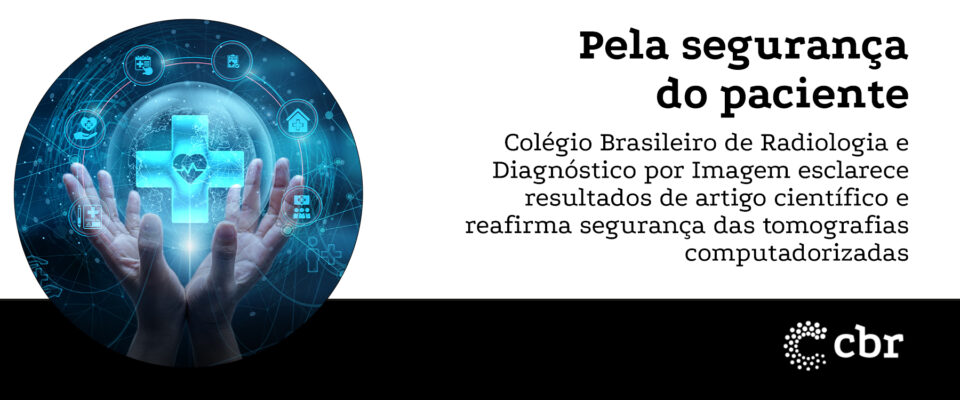The use of computed tomography (CT) in the diagnosis of diseases is safe and effective, contributing to the reduction of mortality rates and an increase in life expectancy. This type of imaging exam also has a positive impact on the reduction in the number of invasive surgeries, unnecessary hospitalizations and length of hospital stay. Therefore, patients should continue to undergo CT scans whenever indicated by their doctors, with transparent dialogue about the benefits and risks involved.
The warning from the Brazilian College of Radiology and Diagnostic Imaging (CBR) came in the form of a public note that clarifies points from an article published in JAMA Internal Medicine. The study suggests that if current radiation dosage and use practices continue in these procedures, CT-associated cancers could eventually account for 5% of all new diagnoses of this disease per year.
CHECK OUT THE FULL NOTE FROM THE CBR ON THE SAFETY OF TCs
According to the president of CBR, Dr. Rubens Chojniak, the Brazilian College of Radiology and Diagnostic Imaging considers it essential to inform the population and health professionals about the data disclosed in the article recently published in the press based on a study by the University of California (UCSF).
“It is essential to properly contextualize the data released to avoid alarmist interpretations that could generate unfounded fears and even harm the health of the population. The study mentioned is based on mathematical models derived from data from survivors of the atomic bombs in Hiroshima and Nagasaki, whose exposure to radiation was acute, of non-medical origin, and therefore in circumstances very different from those that occur in examinations,” said Rubens Chojniak.
He further explained that the model used assumes that any dose of radiation, no matter how small, proportionally increases the risk of cancer. This premise, however, is controversial, especially in the case of repeated low doses, such as those used in most CT scans performed today. It is important to highlight that the study does not present a survey based on direct clinical observations, but rather on theoretical estimates.
Good practices – “The CBR values scientific debate and recognizes the importance of promoting the conscious and judicious use of medical radiation. For this reason, it regularly publishes educational materials and encourages ongoing discussions on best practices in the use of imaging exams. It also supports international initiatives such as Image Wisely and Image Gently, which guide professionals and patients on the safety and appropriateness of radiation use, especially in more sensitive populations,” Chojniak also highlighted. Other important international organizations have also expressed similar views on the subject, such as the American College of Radiology (ACR) and the American Association of Physicists in Medicine (AAPM), a medical physics organization that represents more than 9,000 professionals in 96 countries.
The use of CT scans and other imaging tests greatly improves the health of the population, says the CBR, which in the note makes some recommendations to patients and their families so that everything can be carried out in an even safer and more efficient way. Among the recommendations is to talk to your doctor about how each of the different types of procedures works and the advantages and risks involved.
When contacting the doctor, the patient or family member can ask about alternatives to the use of CT scans that do not use radiation and are equally effective, such as magnetic resonance imaging or ultrasound, ensuring the degree of specificity desired by the doctor for each case.
Another important measure is to check the infrastructure of the location where the exams will be performed (equipment standards, regular assessments, possession of certifications and confirmation that the reports are issued by radiologists with rigorous training and qualification criteria). Finally, the CBR recommends that the results of the imaging exams be saved for later comparisons.
Useful tool – CT scans produce detailed images of the body, offering more information than standard X-rays. “The use of CT scans is safe, effective and widely recognized by the medical community as a fundamental tool for the early diagnosis, monitoring and treatment of various diseases. Evidence shows, for example, that CT scans drastically reduce diagnostic errors in cases such as appendicitis, in addition to being decisive in the screening and early detection of cancers such as lung cancer,” said the president of the College.
In the Brazilian context, the main challenge for public health is often access to this type of examination in certain regions. The unavailability of tomography represents a real and more immediate risk to the health of the population than the theoretical effects of the responsible use of medical radiation. “The Brazilian College of Radiology and Diagnostic Imaging remains attentive to scientific and technological advances, and remains at the disposal of society and public and private health managers to contribute with evidence-based information that ensures Brazilians have access to safe, ethical and excellent diagnostic imaging.”




